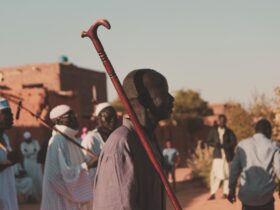A brief scroll through TikTok, a novel social media platform known for short videos and a powerful algorithm for suggested content, could include American teenagers dancing a snappy routine, social advocates preaching their cause and renditions of the viral “Ratatouille Musical.”
Although TikTok has a reputation for viral dancing routines and light-hearted comedic content, more sinister content lurks beyond these jovial videos. Young men dancing with semi-automatic weapons, armored trucks packing bricks of cocaine through the Mexican countryside, tiger cubs in the backseats of sports cars and stacks of freshly printed cash can all be found on TikTok.
Young cartel members post videos of counting their money in a crowded club, slinging back shots and joking about their lucrative profession, boasting their new wealth and power. New recruits may post these videos because they are eager to showcase their exciting lifestyle, but some experts fear this could be an advancement of recruitment tactics for violent organized crime. These highly circulated videos heighten the glamor of the lifestyle and obscure the risks, normalizing illegal activity and possibly attracting impressionable viewers into the sinister network of cartels.
Videos documenting the daily lives of cartel members in Mexico first began to gain popularity on TikTok in July of 2019. One video captured a high-speed boat chase, including screams from the people attempting to swerve away from the armored boat in their wake. The now infamous “boat video” had millions of views before TikTok took it down for showing illegal activity.
However, TikTok has not managed to remove all content related to cartels, despite its pledge to work “with law enforcement to combat organized criminal activity” by removing “content and accounts that promote illegal activity.”
Cartel content continues to circulate, partially because users manage to circumvent regulations by avoiding direct depictions of illegal activities and substances, but also because content disseminates more rapidly through TikTok’s algorithm than content moderators can monitor. Drug cartels have been propagating their influence on social media platforms for years, but TikTok’s powerful algorithm and massive following allows cartels to amplify their activities to an unprecedented degree.
The algorithm that powers TikTok’s “For You” page, the section of the app that suggests content to users based on their viewing patterns, ensures that anyone who viewed even a single cartel-related video would view a constant stream of similar content. Anyone who spends a significant amount of time perusing the “For You” page has likely stumbled across the “boat video” or some other similar content. This stream of content from drug runners and gangs has been dubbed #CartelTikTok.
At first glance, cartel content may seem relatively benign, just an entertaining glimpse into the lives of people who seem to lead the lives of movie characters. Is #CartelTikTok actually that different from the critically acclaimed show “Narcos,” which dramatizes the life of drug kingpin Pablo Escobar? Both platforms illustrate the wealth and glamor achieved by illegal activity and can romanticize the danger associated with a criminal lifestyle.
And, perhaps more importantly, both platforms attract a significant young audience.
However, the nature of TikTok, a social media platform dominated by average people posting about their daily lives, normalizes this violence in a way that a multi-million-dollar Netflix original does not.
Although Cartel TikTok has emerged too recently for studies to explore its repercussions, scholarly research already suggests that social media enables individuals around the world to join a cause or ideology, rallying support for both social activism campaigns and extremist groups. Social media has a particular capacity to expose impressionable communities to radical ideas and actions, normalizing criminal activity and facilitating echo chambers.
TikTok channels have begun to function as a forum for gang members to present their criminal activities with minimal fear of repercussion, constructing a community that more closely mimics actual interpersonal relationships than television shows can. Prior to social media, organized crime relied on word-of-mouth for recruitment, but TikTok allows for widespread dissemination of advertisement of their culture, power and wealth.
Cartel content on TikTok exposes young, impressionable adolescents in Mexico and around the world to cartel culture, showing them that the drama and extreme wealth of mob movies is tangible and attainable. Experts warn that #CartelTikTok could produce a new generation of young recruits to gangs.
Cartels are not new to social media. Gang-related content has circulated throughout the underchannels of the internet since the advent of social media, including videos of brutal beheadings and violent crimes posted anonymously on Facebook, Youtube and various other blogs. For many years, cartels have wielded social media as a weapon of intimidation, terrifying citizens and making a statement to law enforcement.
However, cartel presence on social media has evolved with the platform, and their content has become more sophisticated and designed to not only assert their power but also to endear themselves to the community. Many viral videos are designed to demonstrate how the life of a gang member is both glamorous and fun. Viral videos show members dancing to traditional music and hardworking farmers in poppy fields, giving the impression that their work is honest and occasionally enjoyable, just like many average citizens.
Alejandra León Olvera, an anthropologist studying the social media presence of Mexican organized crime at the University of Murcia in Spain, calls this presence of organized crime on social media “narco-marketing.”
As murder rates in Mexico continue to set record highs, social media content that could spawn a new wave of recruits presents an immediate danger to the country’s wellbeing. President Andres Manuel Lopez Obrador has waged war against organized crime in Mexico since he assumed office in 2018, but his campaign promises remain unfulfilled.
Under the slogan “Hugs, not Bullets,” Lopez Obrador campaigned to fight cartels with a strategy of military restraint and economic development, promising to diminish the power of cartels by stabilizing the economy rather than escalating violence with further military confrontation. Even before cartel culture made waves on TikTok, Lopez Obrador’ policy had attracted criticism.
The Organization for World Peace compared his “Hugs Not Bullets” approach to Chamberlain’s appeasement of the Third Reich, claiming that his relaxed approach to military force enabled drug lords to continue their business with less fear of judicial retribution. Despite the efforts of Lopez Obrador, drug rings have managed to fuel their influence over Mexican citizens with a perpetual supply of voluntary labor, employing social media and TikTok to appeal to potential members. With the rise of cartel culture, his strategies appear even more defenseless against the rising popularity of cartel culture.
Beyond rising death tolls and drug violence in Mexico, this trend of cartel culture on TikTok creates a new dimension to the ongoing discussion surrounding social media, censorship and politics on the international stage.
TikTok is not the only social media platform grappling with its accountability for the content circulating among users. In November of 2020, US lawmakers drilled CEO of Facebook Mark Zuckerberg and CEO of Twitter Jack Dorsey about the amount of harmful, hateful and false information circulating on their respective platforms. While many Democratic lawmakers pressed social media giants about their inability or unwillingness to silence offensive and incorrect content, many Republicans urged Zuckerberg and Dorsey to relax their approach to content moderation.
Their discussion boils down to a question of how to balance free speech with public risk when content rapidly circulates across national borders, a debate that pertains to #CartelTikTok. Should TikTok be doing more to remove misleading content, especially videos that could influence young minds?
Recently, social media companies such as Twitter, Snapchat and Instagram have altered their stance on eliminating false information by blocking former president Donald Trump following his inciting comments surrounding the storming of the U.S. Capitol on January 6, 2021. This move suggests that social media leaders are preparing to take a firmer stance against potentially damaging content, even at the expense of unbridled free speech.
#CartelTikTok is a new dimension of this debate about free speech and content moderation on social media. Young gang members are posting videos of illegal activity in Mexico on a Chinese owned social media platform and reaching audiences around the world, with particular popularity among teenagers in the United States. So, whose responsibility, if anyone’s, is it to monitor this content and limit its potentially dangerous consequences?







